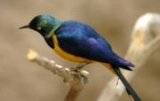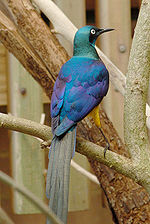
Golden-breasted Starling
Encyclopedia
The Golden-breasted Starling, Cosmopsarus regius also known as Royal Starling is a medium-sized, up to 35cm long, passerine
in the starling
family. The adult has a metallic green head and upperback, bright golden yellow breast and belly, dark bill
and legs, white iris
and metallic violet blue on wings, back, neck and its long tail feathers. Both sexes are similar. The young is duller than adult.
 The Golden-breasted Starling is distributed to the grassland
The Golden-breasted Starling is distributed to the grassland
, savanna
and shrubland
of East Africa
, from Somalia
, Ethiopia
, Kenya
and northern Tanzania
.
The Golden-breasted Starling is a social animal
, living in groups of three to twelve individuals. Its diet consists mainly of insect
s and termite
s. Adult birds catch insects in flight and dig up termite mounds to find prey. The Golden-breasted Starling molts once a year, after the breeding season.
The female usually lays between three to five pale green eggs with red speckles. It nests in tree holes. The nest is made from leaves, roots and other vegetation matters. Entire family groups cooperate in raising young by gathering food and nesting materials.
Widespread throughout its habitat range, the Golden-breasted Starling is evaluated as Least Concern on the IUCN Red List
of Threatened Species.
Passerine
A passerine is a bird of the order Passeriformes, which includes more than half of all bird species. Sometimes known as perching birds or, less accurately, as songbirds, the passerines form one of the most diverse terrestrial vertebrate orders: with over 5,000 identified species, it has roughly...
in the starling
Starling
Starlings are small to medium-sized passerine birds in the family Sturnidae. The name "Sturnidae" comes from the Latin word for starling, sturnus. Many Asian species, particularly the larger ones, are called mynas, and many African species are known as glossy starlings because of their iridescent...
family. The adult has a metallic green head and upperback, bright golden yellow breast and belly, dark bill
Beak
The beak, bill or rostrum is an external anatomical structure of birds which is used for eating and for grooming, manipulating objects, killing prey, fighting, probing for food, courtship and feeding young...
and legs, white iris
Iris (anatomy)
The iris is a thin, circular structure in the eye, responsible for controlling the diameter and size of the pupils and thus the amount of light reaching the retina. "Eye color" is the color of the iris, which can be green, blue, or brown. In some cases it can be hazel , grey, violet, or even pink...
and metallic violet blue on wings, back, neck and its long tail feathers. Both sexes are similar. The young is duller than adult.

Grassland
Grasslands are areas where the vegetation is dominated by grasses and other herbaceous plants . However, sedge and rush families can also be found. Grasslands occur naturally on all continents except Antarctica...
, savanna
Savanna
A savanna, or savannah, is a grassland ecosystem characterized by the trees being sufficiently small or widely spaced so that the canopy does not close. The open canopy allows sufficient light to reach the ground to support an unbroken herbaceous layer consisting primarily of C4 grasses.Some...
and shrubland
Shrubland
Shrubland, scrubland, scrub or brush is a plant community characterized by vegetation dominated by shrubs, often also including grasses, herbs, and geophytes. Shrubland may either occur naturally or be the result of human activity...
of East Africa
East Africa
East Africa or Eastern Africa is the easterly region of the African continent, variably defined by geography or geopolitics. In the UN scheme of geographic regions, 19 territories constitute Eastern Africa:...
, from Somalia
Somalia
Somalia , officially the Somali Republic and formerly known as the Somali Democratic Republic under Socialist rule, is a country located in the Horn of Africa. Since the outbreak of the Somali Civil War in 1991 there has been no central government control over most of the country's territory...
, Ethiopia
Ethiopia
Ethiopia , officially known as the Federal Democratic Republic of Ethiopia, is a country located in the Horn of Africa. It is the second-most populous nation in Africa, with over 82 million inhabitants, and the tenth-largest by area, occupying 1,100,000 km2...
, Kenya
Kenya
Kenya , officially known as the Republic of Kenya, is a country in East Africa that lies on the equator, with the Indian Ocean to its south-east...
and northern Tanzania
Tanzania
The United Republic of Tanzania is a country in East Africa bordered by Kenya and Uganda to the north, Rwanda, Burundi, and the Democratic Republic of the Congo to the west, and Zambia, Malawi, and Mozambique to the south. The country's eastern borders lie on the Indian Ocean.Tanzania is a state...
.
The Golden-breasted Starling is a social animal
Social animal
A social animal is a loosely defined term for an organism that is highly interactive with other members of its species to the point of having a recognizable and distinct society.All mammals are social to the extent that mothers and offspring bond...
, living in groups of three to twelve individuals. Its diet consists mainly of insect
Insect
Insects are a class of living creatures within the arthropods that have a chitinous exoskeleton, a three-part body , three pairs of jointed legs, compound eyes, and two antennae...
s and termite
Termite
Termites are a group of eusocial insects that, until recently, were classified at the taxonomic rank of order Isoptera , but are now accepted as the epifamily Termitoidae, of the cockroach order Blattodea...
s. Adult birds catch insects in flight and dig up termite mounds to find prey. The Golden-breasted Starling molts once a year, after the breeding season.
The female usually lays between three to five pale green eggs with red speckles. It nests in tree holes. The nest is made from leaves, roots and other vegetation matters. Entire family groups cooperate in raising young by gathering food and nesting materials.
Widespread throughout its habitat range, the Golden-breasted Starling is evaluated as Least Concern on the IUCN Red List
IUCN Red List
The IUCN Red List of Threatened Species , founded in 1963, is the world's most comprehensive inventory of the global conservation status of biological species. The International Union for Conservation of Nature is the world's main authority on the conservation status of species...
of Threatened Species.
External links
- BirdLife Species Factsheet
- Golden-breasted Starling videos on the Internet Bird Collection

